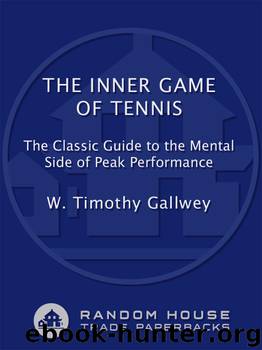The Inner Game of Tennis by W. Timothy Gallwey

Author:W. Timothy Gallwey [Gallwey, W. Timothy]
Language: eng
Format: epub, mobi
ISBN: 978-0-307-75885-9
Publisher: Random House Publishing Group
Published: 2010-06-29T16:00:00+00:00
HOW TO WATCH THE PROS
When I was a child, I used to play touch football, and I noticed that I played quite a lot better when I’d just come home after my Dad had taken me to see the San Francisco 49ers play. I hadn’t studied the passing technique of Frankie Albert. But I had picked up something, and it made a difference when I played. I think most people have experienced something very similar to this.
Although it is obvious that we can learn a great deal by watching better players play tennis, we have to learn how to watch. The best method is to simply watch without assuming that how the pro swings is how you should be swinging. In many cases, for a beginner to try to swing like a pro would be like asking a baby to walk before it has crawled. To formulate technique while watching the pro or by trying to imitate too closely can be detrimental to your natural learning process.
Instead allow yourself to focus on whatever most interests you about the movements of the pro you are watching. Self 2 will automatically pick up elements of the stroke that are useful to it and discard what is not useful. With each new swing, observe how it feels and how it works. Allow the natural learning process to lead you toward your best stroke. Do not force yourself to make the change. Just allow Self 2 to “play around” while it searches for new stroke possibilities. In doing so it will use what it can of the “hints” picked up in observation of the pro.
Based on my experience and the experience of those I have worked with, Self 2 has very good instincts about when it is time to work on any particular element of your stroke. In learning how to learn by watching pros play, you may want to alternate between external observation and experimentation on the court, until you have confidence that you can access the particular stroke technique you are working on.
With the Inner Game approach, the final authority stays inside during the alternation between external observation (or remembrance of an external instruction) and total focus of awareness on your own movements. But there is no judgment necessary in the process. You see differences between what you are doing and the external model, but simply notice them and continue to observe, feel your own movements and check the results. The prevailing learning mind-set is a freedom to search for the feel that works for you.
In summary, I believe someone who has discovered his or her best stroke can help you discover your best stroke. Knowledge of technique learned by one person can give another an advantage in discovering what technique works best. But it is dangerous to make that person’s stroke or any stroke description into your standard for right and wrong. Self 1 easily gets enamored of formulas that tell it where the racket should be and when. It likes the feeling of control it gets from doing it by the book.
Download
The Inner Game of Tennis by W. Timothy Gallwey.mobi
This site does not store any files on its server. We only index and link to content provided by other sites. Please contact the content providers to delete copyright contents if any and email us, we'll remove relevant links or contents immediately.
Unstoppable by Maria Sharapova(3186)
The Inner Game of Tennis by W. Timothy Gallwey(3143)
Urban Outlaw by Magnus Walker(3046)
Crazy Is My Superpower by A.J. Mendez Brooks(2964)
Mind Fuck by Manna Francis(2773)
The Social Psychology of Inequality by Unknown(2434)
The Fight by Norman Mailer(2255)
Unstoppable: My Life So Far by Maria Sharapova(2201)
Accepted by Pat Patterson(2006)
Going Long by Editors of Runner's World(1993)
Motorcycle Man by Kristen Ashley(1928)
Backpacker the Complete Guide to Backpacking by Backpacker Magazine(1905)
The Happy Runner by David Roche(1901)
Futebol by Alex Bellos(1892)
The Sports Gene: Inside the Science of Extraordinary Athletic Performance by David Epstein(1886)
Sea Survival Handbook by Keith Colwell(1860)
Peak: Secrets from the New Science of Expertise by Anders Ericsson & Robert Pool(1750)
Endure by Alex Hutchinson(1686)
The Call of Everest by Conrad Anker(1609)
